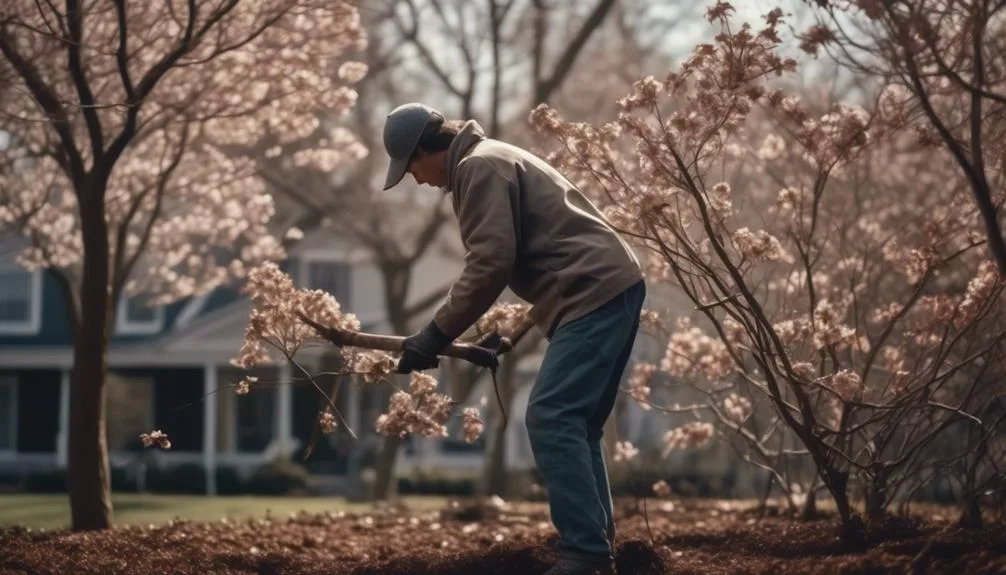Wondering about the care of dogwood trees?
Their beautiful flowers and foliage make them stand out in any garden.
Let's discuss the effort needed for their care.
We'll cover soil, water needs, and disease control to understand the level of attention these trees require.
Soil and Water Requirements
To ensure the health and vitality of your dogwood tree, it's essential to provide consistent moisture and well-draining soil. When it comes to maintaining your dogwood's soil and water requirements, a proper fertilization schedule is crucial.
In the early spring, before new growth begins, apply a balanced slow-release fertilizer to support healthy development.
As for mulching techniques, a 2 to 4-inch layer of organic mulch, such as wood chips or shredded bark, can help retain soil moisture, regulate soil temperature, and deter competing weeds. Remember to keep the mulch a few inches away from the trunk to prevent rot.
Additionally, regular watering is vital, especially during dry periods, to keep the soil consistently moist but not waterlogged.
Pruning and Trimming Needs
For optimal growth and health of your dogwood tree, regular pruning and trimming are essential maintenance tasks.
Branch shaping is necessary to maintain an attractive and well-balanced tree structure. Start by removing any dead, diseased, or crossing branches. This not only improves the tree's appearance but also enhances air circulation and reduces the risk of disease.
Additionally, trimming back overgrown branches helps to maintain the tree's overall shape and size.
Fall cleanup is an important part of dogwood tree care. Removing any dead or diseased branches before winter sets in can help prevent the spread of disease and protect the tree from potential damage caused by heavy snow or ice.
Proper pruning and trimming will promote new growth and ensure that your dogwood tree remains healthy and beautiful year after year.
Disease and Pest Management
After addressing the pruning and trimming needs of your dogwood tree, it's crucial to turn your attention to effective disease and pest management to safeguard its health and vitality.
Prevention is key in maintaining a healthy dogwood tree. Regularly inspect the tree for signs of disease or pest infestation, such as discolored or spotted leaves, unusual wilting, or visible pests.
Natural remedies, like neem oil or horticultural oils, can be used to combat certain pests and diseases effectively. However, if the infestation is severe, chemical treatments may be necessary. When considering treatment options, always prioritize those that are least harmful to beneficial insects and the environment.
Sunlight and Location Considerations
Positioning your dogwood tree in a location that receives partial shade and well-drained soil is essential for its optimal growth and health. Here are some planting tips and ideal conditions to consider:
- Sun Exposure: Dogwood trees thrive in partial shade, especially during hot afternoon hours. It's best to avoid planting them in full sun, as it can lead to leaf scorch and stress.
- Best Locations: Look for areas in your garden or landscape that offer dappled sunlight or morning sun with protection from harsh afternoon rays. Consider planting near taller trees or on the east or north side of buildings to provide the ideal lighting conditions.
Seasonal Maintenance Tips
Considering the changing seasons, implementing regular pruning and mulching is essential to ensure the continued health and vitality of your dogwood tree. To help you maintain your tree throughout the year, here are some seasonal maintenance tips:
| Season | Maintenance Tips |
|---|---|
| Spring | – Prune dead or diseased branches. |
| – Apply a balanced fertilizer. | |
| Summer | – Water deeply during dry spells. |
| – Monitor for pests and diseases. | |
| Fall | – Mulch around the base for winter protection. |
| – Prepare for colder temperatures. | |
| Winter | – Avoid heavy pruning during dormancy. |
| – Protect the tree from freezing winds. |
Conclusion
In nurturing your dogwood tree with proper soil, water, sunlight, pruning, and pest management, you can minimize the maintenance it requires.
By staying attuned to seasonal changes and adjusting care as needed, your dogwood tree can flourish with minimal effort, enhancing the beauty of your yard.
Happy gardening!

My interest in trees started when I first saw the giant sequoias in Yosemite.
I was a teenager then, and I remember thinking, “I need to learn more about this.”
That moment stuck with me.
A few years later, I went on to study forestry at Michigan Tech.
Since graduating, I’ve worked in a mix of hands-on tree care and community education.
I’ve spent over ten years helping people understand how to plant, maintain, and protect the trees in their neighborhoods.
I don’t see trees as just part of the landscape.
They are living things that make a real difference in our daily lives.
